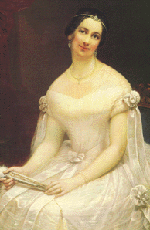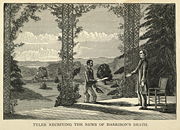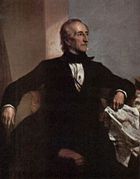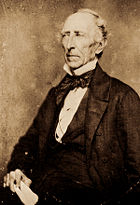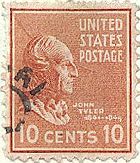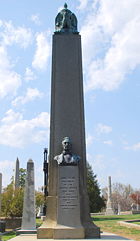John Tyler
2008/9 Schools Wikipedia Selection. Related subjects: USA Presidents
|
John Tyler
|
|
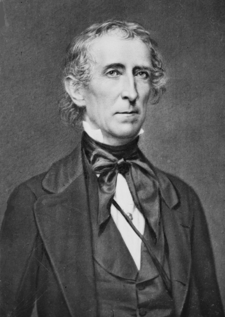 Daguerreotype of President Tyler taken in 1845 by Brady |
|
|
|
|
|---|---|
| In office April 4, 1841 – March 4, 1845 |
|
| Vice President | None |
| Preceded by | William Henry Harrison |
| Succeeded by | James K. Polk |
|
10th Vice President of the United States
|
|
| In office March 4, 1841 – April 4, 1841 |
|
| President | William Henry Harrison |
| Preceded by | Richard Mentor Johnson |
| Succeeded by | George Dallas |
|
23rd Governor of Virginia
|
|
| In office December 10, 1825 – March 4, 1827 |
|
| Preceded by | James Pleasants |
| Succeeded by | William Branch Giles |
|
United States Senator
from Virginia |
|
| In office March 4, 1827 – February 29, 1836 |
|
| Preceded by | John Randolph of Roanoke |
| Succeeded by | William C. Rives |
|
President pro tempore of the United States Senate
|
|
| In office March 3, 1835 – December 6, 1835 |
|
| Preceded by | George Poindexter |
| Succeeded by | William R. King |
|
|
|
| Born | March 29, 1790 Charles City County, Virginia |
| Died | January 18, 1862 (aged 71) Richmond, Virginia |
| Nationality | American |
| Political party | Whig, Democrat |
| Spouse | Letitia Christian Tyler (1st wife) Julia Gardiner Tyler (2nd wife) |
| Alma mater | The College of William and Mary |
| Occupation | Lawyer |
| Religion | Episcopal (possibly Deist) |
| Signature | |
John Tyler, Jr. ( March 29, 1790 – January 18, 1862) was the tenth President of the United States (1841-1845). A long-time Democrat-Republican, he was elected Vice President on the Whig ticket and on becoming president in 1841, broke with that party. His term as Vice President began on March 4, 1841 and one month later, on April 4, incumbent President William Henry Harrison died of what is today believed to have been viral pneumonia. Harrison's death left Tyler, the federal government, and the American nation briefly confused on the process of succession. Opposition members in Congress argued for an acting caretaker that would continue to use only the title Vice President. The act of taking over as official president, rather than as acting president, came from the influence of the Harrison cabinet and some members of Congress. Members of Harrison's cabinet feared an acting leader would compromise the ability to successfully run the country. Tyler took the presidential oath of office on April 6, 1841, initiating a custom that would govern future successions, and became the first U.S. vice president to assume the office of president upon the death of his predecessor. It was not until 1967 that Tyler's action of assuming full powers of the presidency was legally codified in the Twenty-fifth Amendment. His most famous achievement was the annexation of the Republic of Texas in 1845. Tyler was the first president born after the adoption of the U.S. Constitution.
Early life
John Tyler was born the son of John Tyler, Sr. (1747-1813) and Mary Armistead (1761-1797), in Charles City County, Virginia, as the second of eight children, and reputedly a descendant of Wat Tyler. He is the first President born after the Ratification of the Constitution of the United States (Virginia having ratified it in 1788) making him the first President to be born a United States Citizen. He was educated at the College of William and Mary and went on to study law with his father, who became Governor of Virginia (1808-1811). Tyler was admitted to the bar in 1809 and commenced practice in Charles City County. He served as a captain of a volunteer military company in 1813 and became a member of the Virginia House of Delegates 1811-1816 and was later a member of the council of state in 1816.
Career
John Tyler was elected as a Democratic-Republican to the Fourteenth Congress to fill the vacancy caused by the death of John Clopton. He was reelected to the Fifteenth and Sixteenth Congresses and served from December 17, 1816, to March 3, 1821 in the House of Representatives. Tyler declined to be a candidate for renomination in 1820 because of impaired health. He became a member of the Virginia State house of delegates 1823-1825. Tyler was elected to be the Governor of Virginia (1825-1827). He was popularly known as voting against nationalist legislations and for his open opposition of the Compromise.
Tyler was elected as a Jacksonian (later Anti-Jacksonian) to the United States Senate in 1827. He was reelected in 1833 and served from March 4, 1827, to February 29, 1836, when he resigned. He served as President pro tempore of the Senate during the Twenty-third Congress (the only President to have served as President pro tempore of the Senate), and was chairman of the Committee on the District of Columbia (Twenty-third and Twenty-fourth Congresses), as well as the Committee on Manufactures (Twenty-third Congress), a member of the Virginia State constitutional convention in 1829 and 1830 and a member of the Virginia State House of Delegates in 1839.
He was drawn into the newly-organized Whig Party, and was elected Vice President in 1840 as running mate to William Henry Harrison. Their campaign slogans of "Log Cabins and Hard Cider" and " Tippecanoe and Tyler too" are among the most famous in American politics. "Tippecanoe and Tyler too" not only offered the slight sectionalism that would further be apparent in the presidency of Tyler, but also the nationalism that was imperative to gain the American vote. He was inaugurated March 4, 1841, and served until Harrison's death on April 4, 1841. Upon Harrison's death, Tyler became the new President. Tyler was the first Vice President to assume the Presidency in this manner.
He took the presidential oath of office as specified by the Constitution on April 6. The Cabinet and Senate agreed with Tyler that he was President and not merely Acting President of the United States, and as the Constitution was not explicit on that aspect of succession (until the 1967 ratification of the 25th Amendment), both the House and Senate passed resolutions recognizing Tyler as President. He even delivered an Inaugural Address, proving his formal entrance into the position.
After his presidential career Tyler became a delegate to and president of the peace convention held in Washington, D.C. in 1861 as an effort to devise means to prevent the impending war. Tyler was a delegate to the Provisional Confederate Congress in 1861; elected to the House of Representatives of the Confederate Congress, but died in Richmond, Virginia before he could assume office. He is buried in Hollywood Cemetery.
John Tyler was married twice. His first wife was Letitia Christian Tyler, with whom he had eight children. She died in the White House in September 1842. His second wife was Julia Gardiner Tyler ( July 23, 1820 - July 10, 1889), with whom he had seven children.
Presidency 1841-1845
Policies
Tyler's Presidency was rarely taken seriously in his time. He was usually referred to as the "Acting President" or "His Accidency" by opponents. Further, Tyler quickly found himself at odds with his former political supporters. Harrison had been expected to adhere closely to Whig Party policies and work closely with Whig leaders, particularly Henry Clay. Tyler shocked Congressional Whigs by vetoing virtually their entire agenda, twice vetoing Clay's legislation for a national banking act following the Panic of 1837 and leaving the government deadlocked. Tyler was officially expelled from the Whig Party in 1841, a few months after taking office, and became known as "the man without a party." The entire cabinet he had inherited from Harrison resigned in September, aside from Daniel Webster, Secretary of State, who remained to finalize the Webster-Ashburton Treaty in 1842, demonstrating his independence from Clay.
For two years, Tyler struggled with the Whigs, but when he nominated John C. Calhoun as Secretary of State, to 'reform' the Democrats, the gravitational swing of the Whigs to identify with "the North" and the Democrats as the party of "the South," led the way to the sectional party politics of the next decade. Tyler was the first president to have a veto overridden by Congress, when both houses overrode a veto on a bill relating to revenue cutters and steamers on Tyler's last full day in office; March 3, 1845.
The last year of Tyler's presidency was marred by a freak accident that killed two of his Cabinet members. During a ceremonial cruise down the Potomac River on February 28, 1844, the main gun of the USS Princeton blew up during a demonstration firing, instantly killing Thomas Gilmer, the Secretary of the Navy, and Abel P. Upshur, the Secretary of State. Julia Gardiner (whom Tyler had met two years earlier at a reception, and would go on to become his second wife) was also aboard the Princeton that day. Her father, David Gardiner, was among those killed during the explosion. Upon hearing of her father's death, Gardiner fainted into the President's arms. Tyler and Gardiner were married not long afterwards in New York City, on June 26, 1844.
Annexation of Texas
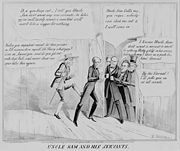
An anti-Tyler satire lampoons President Tyler's efforts to secure a second term against challengers Whig Henry Clay and Democrat James K. Polk. Clay, Polk, John C. Calhoun and Andrew Jackson attempt to get in as Tyler pushes the door shut on them. Uncle Sam demands that Tyler stop and let Clay in.
Tyler advocated annexation of Texas to the Union. Many Whigs opposed this expansion because it would upset the balance between North and South and risked war with Mexico. However the Whigs lost the 1844 election to James K. Polk, who favored annexation. When the Senate blocked a treaty (which needed a 2/3 vote), Tyler pushed Congress to annex Texas through an adopted joint resolution. The tactic worked and it passed the House 132-72 and the Senate 27-25. The Missouri Compromise helped to promise security to the west of the United States with the line of 36°30'N. Such meant that any states north of the line would be free and those south of the line would be open to slavery. The option to potentially have four more states south of the line, left the House ready and willing to pass the bill. On March 3, Tyler sent instructions to his representative in Texas, Andrew Jackson Donelson, to announce the annexation. The next day, he left office. Even with a brief period of skeptical instinct, Polk told Donelson to carry out the orders of Tyler. Texas formally joined the Union on December 29, 1845, when James K. Polk was President.
Rhode Island's Dorr Rebellion
In May 1842, when the Dorr Rebellion in Rhode Island came to a head, Tyler pondered the request of the governor and legislature to send in Federal troops to help it suppress the Dorrite insurgents. The insurgents under Thomas Dorr had armed themselves and proposed to install a new state constitution. Previous to such acts, Rhode Island had been following the same constitutional structure that was established in 1663. Tyler called for calm on both sides, and recommended the governor enlarge the franchise to let most men vote. Tyler promised that in case an actual insurrection should break out in Rhode Island he would employ force to aid the regular, or Charter, government. He made it clear that federal assistance would be given, not to prevent, but only to put down insurrection, and would not be available until violence had been committed. After listening to reports from his confidential agents, Tyler decided that the 'lawless assemblages' were dispersing and expressed his confidence in a "temper of conciliation as well as of energy and decision." He did not send any federal forces. The rebels fled the state when the state militia marched against them. With their dispersion, they accepted the expansion of suffrage.
Separation of Church and State
On July 10, 1843, President Tyler wrote a letter to Joseph Simpson which included the following text.
The United States has adventured upon a great and noble experiment, which is believed to have been hazarded in the absence of all previous precedent — that of total separation of Church and State. No religious establishment by law exists among us. The conscience is left free from all restraint and each is permitted to worship his Maker after his own judgment. The offices of the Government are open alike to all. No tithes are levied to support an established Hierarchy, nor is the fallible judgment of man set up as the sure and infallible creed of faith. The Mohammedan, if he will to come among us would have the privilege guaranteed to him by the Constitution to worship according to the Koran; and the East Indian might erect a shrine to Brahma if it so pleased him. Such is the spirit of toleration inculcated by our political institutions… The Hebrew persecuted and down trodden in other regions takes up his abode among us with none to make him afraid… and the Aegis of the government is over him to defend and protect him. Such is the great experiment which we have tried, and such are the happy fruits which have resulted from it; our system of free government would be imperfect without it.
Impeachment attempt
In 1843, after he vetoed a tariff bill, the House of Representatives considered the first impeachment resolution against a president in American history. A committee headed by former president John Quincy Adams concluded that Tyler had misused the veto, but the impeachment resolution did not pass.
Nicknames
John Tyler had three main nicknames. His first one was "Honest John" because he was honest and kind to the people. His second one was "His Accidency" because no one thought he should have been president when Harrison died in office, but as vice president he thought he should become president. His third one was "The Veto President" because he had vetoed so many Congressional bills.
Administration and Cabinet
| The Tyler Cabinet | ||
|---|---|---|
| Office | Name | Term |
| President | John Tyler | 1841–1845 |
| Vice President | None | 1841–1845 |
| Secretary of State | Daniel Webster (W) | 1841–1843 |
| Abel P. Upshur (W) | 1843–1844 | |
| John C. Calhoun (D) | 1844–1845 | |
| Secretary of Treasury | Thomas Ewing, Sr. (W) | 1841 |
| Walter Forward (W) | 1841–1843 | |
| John C. Spencer (W) | 1843–1844 | |
| George M. Bibb (D) | 1844–1845 | |
| Secretary of War | John Bell (W) | 1841 |
| John C. Spencer (W) | 1841–1843 | |
| James M. Porter (W) | 1843–1844 | |
| William Wilkins (D) | 1844–1845 | |
| Attorney General | John J. Crittenden (W) | 1841 |
| Hugh S. Legaré (D) | 1841–1843 | |
| John Nelson (W) | 1843–1845 | |
| Postmaster General | Francis Granger (W) | 1841 |
| Charles A. Wickliffe (W) | 1841–1845 | |
| Secretary of the Navy | George E. Badger (W) | 1841 |
| Abel P. Upshur (W) | 1841–1843 | |
| David Henshaw (D) | 1843–1844 | |
| Thomas W. Gilmer (D) | 1844 | |
| John Y. Mason (D) | 1844–1845 | |
Supreme Court appointments
Tyler appointed the following Justices to the Supreme Court of the United States:
- Samuel Nelson - 1845
Nelson's successful confirmation in February 1845 was a surprise. Tyler had failed to fill the vacancy left by Smith Thompson, as the Whig-controlled Senate rejected his multiple nominees of John Spencer, Ruben Walworth, Edward King and John Read. King was rejected twice. Nelson, while a Democrat, had a reputation as a careful and noncontroversial jurist.
States admitted to the Union
- Florida – March 3, 1845
Post-Presidency
Tyler retired to a Virginia plantation located on the James River in Charles City County, Virginia and originally named "Walnut Grove." He renamed it " Sherwood Forest" to signify that he had been "outlawed" by the Whig party. He withdrew from electoral politics, though his advice continued to be sought by states-rights Democrats.
Confederate allegiances and death
Tyler had long been an advocate of states' rights, believing that the question of a state's "free" or "slave" status ought to be decided at the state level, with no input from federal government. He was a slaveholder for his entire life. He re-entered public life to sponsor and chair the Virginia Peace Convention in February 1861. The convention sought a compromise to avoid civil war while the Confederate Constitution was being drawn up at the Montgomery Convention. When the Senate rejected his plan, Tyler urged Virginia's immediate secession.
Having served in the provisional Confederate Congress in 1861, he was elected to the Confederate House of Representatives but died of bronchitis and bilious fever before he could take office. His final words were "I am going now, perhaps it is for the best." Tyler is buried in Hollywood Cemetery in Richmond, Virginia. The city of Tyler, Texas is named for him.
Throughout Tyler's life, he suffered from poor health. Frequent colds occurred every winter as he aged. After his exit from the White House, he fell victim to repeated cases of dysentery. He has been quoted as having many aches and pains in the last eight years of his life. In 1862, after complaining of chills and dizziness, he vomited and collapsed during the Congress of Confederacy. He was revived, yet the next day he admitted to the same symptoms. It was likely that John Tyler died of a stroke.
Tyler's death was the only one in presidential history not to be officially mourned in Washington, because of his allegiance to the Confederacy. Tyler is also sometimes considered the only president to die outside the United States seeing that his place of death, Richmond, Virginia, was part of the Confederate States at the time. Tyler's favorite horse named "The General" is buried at his Sherwood Forest Plantation with a gravestone which reads, "Here lies the body of my good horse 'The General'. For twenty years he bore me around the circuit of my practice and in all that time he never made me blunder. Would that his master could say the same."
Children
In all, Tyler had fifteen children, eight with his first wife Letitia and seven with his second wife Julia. His last surviving child, Pearl Tyler, who was also his last child born, died on June 30, 1947, one hundred years, one week and six days after the death of his first child, Mary Tyler.
- By Letitia Christian Tyler:
- Mary Tyler (1815-47); Robert Tyler (1816-77); John Tyler (1819-96); Letitia Tyler (1821-1907); Elizabeth Tyler (1823-50); Anne Contesse Tyler (1825); Alice Tyler (1827-54); Tazewell Tyler (1830-74)
- By Julia Gardiner Tyler:
- David Gardiner Tyler (1846-1927); John Alexander Tyler (1848-83); Julia Gardiner Tyler (1849-71); Lachlan Tyler (1851-1902); Lyon Gardiner Tyler (1853-1935); Robert Fitzwalter Tyler (1856-1927); Pearl Tyler (1860-1947)
John Dunjee claimed to be the illegitimate son of John Tyler, a child of Tyler and one of his female slaves. There was also a mulatto woman who frequently traveled with the Tyler family who was alleged to be the president's daughter.

